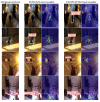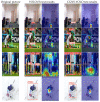A Lightweight Human Fall Detection Network
- PMID: 38005456
- PMCID: PMC10674212
- DOI: 10.3390/s23229069
A Lightweight Human Fall Detection Network
Abstract
The rising issue of an aging population has intensified the focus on the health concerns of the elderly. Among these concerns, falls have emerged as a predominant health threat for this demographic. The YOLOv5 family represents the forefront of techniques for human fall detection. However, this algorithm, although advanced, grapples with issues such as computational demands, challenges in hardware integration, and vulnerability to occlusions in the designated target group. To address these limitations, we introduce a pioneering lightweight approach named CGNS-YOLO for human fall detection. Our method incorporates both the GSConv module and the GDCN module to reconfigure the neck network of YOLOv5s. The objective behind this modification is to diminish the model size, curtail floating-point computations during feature channel fusion, and bolster feature extraction efficacy, thereby enhancing hardware adaptability. We also integrate a normalization-based attention module (NAM) into the framework, which concentrates on salient fall-related data and deemphasizes less pertinent information. This strategic refinement augments the algorithm's precision. By embedding the SCYLLA Intersection over Union (SIoU) loss function, our model benefits from faster convergence and heightened detection precision. We evaluated our model using the Multicam dataset and the Le2i Fall Detection dataset. Our findings indicate a 1.2% enhancement in detection accuracy compared with the conventional YOLOv5s framework. Notably, our model realized a 20.3% decrease in parameter tally and a 29.6% drop in floating-point operations. A comprehensive instance analysis and comparative assessments underscore the method's superiority and efficacy.
Keywords: GDCN module; GSConv module; NAM; SIoU; YOLOv5; fall detection.
Conflict of interest statement
The authors declare no conflict of interest.
Figures












Similar articles
-
LFD-YOLO: a lightweight fall detection network with enhanced feature extraction and fusion.Sci Rep. 2025 Feb 11;15(1):5069. doi: 10.1038/s41598-025-89214-7. Sci Rep. 2025. PMID: 39934394 Free PMC article.
-
Strip steel surface defect detection based on lightweight YOLOv5.Front Neurorobot. 2023 Oct 4;17:1263739. doi: 10.3389/fnbot.2023.1263739. eCollection 2023. Front Neurorobot. 2023. PMID: 37860791 Free PMC article.
-
Research on Safety Helmet Detection Algorithm Based on Improved YOLOv5s.Sensors (Basel). 2023 Jun 22;23(13):5824. doi: 10.3390/s23135824. Sensors (Basel). 2023. PMID: 37447673 Free PMC article.
-
LCGSC-YOLO: a lightweight apple leaf diseases detection method based on LCNet and GSConv module under YOLO framework.Front Plant Sci. 2024 Oct 31;15:1398277. doi: 10.3389/fpls.2024.1398277. eCollection 2024. Front Plant Sci. 2024. PMID: 39544536 Free PMC article.
-
EADD-YOLO: An efficient and accurate disease detector for apple leaf using improved lightweight YOLOv5.Front Plant Sci. 2023 Feb 23;14:1120724. doi: 10.3389/fpls.2023.1120724. eCollection 2023. Front Plant Sci. 2023. PMID: 36909428 Free PMC article.
Cited by
-
Integrating attention mechanism and multi-scale feature extraction for fall detection.Heliyon. 2024 May 21;10(10):e31614. doi: 10.1016/j.heliyon.2024.e31614. eCollection 2024 May 30. Heliyon. 2024. PMID: 38831825 Free PMC article.
-
LFD-YOLO: a lightweight fall detection network with enhanced feature extraction and fusion.Sci Rep. 2025 Feb 11;15(1):5069. doi: 10.1038/s41598-025-89214-7. Sci Rep. 2025. PMID: 39934394 Free PMC article.
-
Fall Detection System Based on Point Cloud Enhancement Model for 24 GHz FMCW Radar.Sensors (Basel). 2024 Jan 19;24(2):648. doi: 10.3390/s24020648. Sensors (Basel). 2024. PMID: 38276339 Free PMC article.
-
Novel concept for the healthy population influencing factors.Front Public Health. 2024 Dec 10;12:1387255. doi: 10.3389/fpubh.2024.1387255. eCollection 2024. Front Public Health. 2024. PMID: 39720812 Free PMC article.
References
-
- Girshick R. Fast R-CNN; Proceedings of the 2015 IEEE International Conference on Computer Vision (ICCV); Santiago, Chile. 7–13 December 2015; New York, NY, USA: IEEE; 2015. pp. 1440–1448.
-
- Dai J., Li Y., He K., Sun J. R-fcn: Object detection via region-based fully convolutional networks. Adv. Neural Inf. Process. Syst. 2016;29
-
- He K., Gkioxari G., Dollár P., Girshick R. Mask R-CNN; Proceedings of the 2017 IEEE International Conference on Computer Vision (ICCV); Venice, Italy. 22–29 October 2017; New York, NY, USA: IEEE; 2017. pp. 2961–2969.
-
- Cai Z., Vasconcelos N. Cascade R-CNN: Delving into high quality object detection; Proceedings of the 2018 IEEE/CVF Conference on Computer Vision And Pattern Recognition; Salt Lake City, UT, USA. 18–23 June 2018; New York, NY, USA: IEEE; 2018. pp. 6154–6162.
MeSH terms
Grants and funding
LinkOut - more resources
Full Text Sources
Medical

